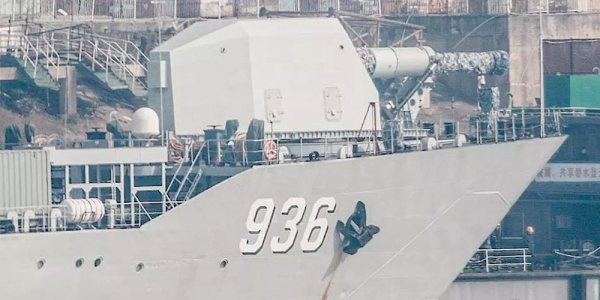It can fire a solid metal slug at speeds of up to 4,500 mph, or Mach 6. It can hit targets up to 100 nautical miles away. It’s capable of defeating incoming ballistic missiles and liquefying even the most durable enemy armor, the equivalent of a weaponized meteor strike fired from the world’s most powerful gun. After more than a decade of research and development and more than $500 million, the Office of Naval Research’s much-hyped electromagnetic railgun prototype is finally capable of flexing its futuristic muscles — but despite the swirl of science-fiction excitement surrounding the muscular new cannon, it will likely never see combat, Task & Purpose has learned.
According to interviews with several congressional and military sources, the much-hyped supergun has come under scrutiny from lawmakers and military planners thanks to the Strategic Capabilities Office, the once-classified department created in 2012 to fast-track new tech languishing in the DoD’s sprawling bureaucracy, and develop, as then-Secretary of Defense Ashton Carter once put it, “game-changing capabilities to confound potential enemies.” With SCO’s interest drawn to other weapons systems, ONR may end up without the necessary funding to push the exceedingly complex railgun toward a critical testing milestone — a delay that, with increasing budget pressures and the DoD’s shifting strategic priorities, could condemn the decade-long project to an inescapable limbo of research and tinkering far from any ship.
‘They’re simply not buying it’
Over the last decade, the Pentagon has funneled money into the development of several next-generation, directed-energy weapons through the Navy’s Research, Development, Testing and Evaluation (RDT&E;) appropriations: The electromagnetic railgun, which has been in development since 2005 in conjunction with defense contractors General Atomics and BAE Systems; the hypervelocity projectile (HVP), a super dense, low-drag tungsten projectile designed as specialized ammo for the railgun; and solid-state lasers, long-time fixations of everyservicebranch and a near-term short-range missile defense for surface vessels. As of a Nov. 30 Congressional Research Service update, electromagnetic railgun research was progressing in line with the ONR roadmap that once envisioned installing the completed weapon on a destroyer like the USS Zumwalt by the mid-2020s.
In recent years, however, SCO has turned its attention to the HVP: once developed explicitly for the railgun, the super-dense shell’s compatibility with conventional powder artillery, offering a cheaper and less technically complex alternative to the Pentagon’s incomplete supergun for not just the Navy, but the Army to rapidly equip.
Related: The Electromagnetic Railgun May Not See Action The Way The Navy Originally Planned »
“SCO shifted the project’s focus to conventional powder guns, facilitating a faster transition of HVP technology to the warfighter,” SCO spokesman Chris Sherwood told Task & Purpose. “Our priority continues to be the HVP, which is reflected in the program’s budget.”
Researchers and policymakers confident on the system’s potential now fear that the reallocation of railgun funding at SCO’s behest will end up forestalling the successful installation and demonstration of a tactical rig aboard a naval vessel. According to multiple legislative and military sources, insufficient funding for the railgun in the current defense budget will grind any meaningful progress to a halt, condemning efforts to R&D; purgatory. As one defense contractor with direct knowledge of the project recently told Task & Purpose, underfunding railgun now would effectively render the decade-long supergun project “dead in the water” by 2019.
“People at SCO don’t want to fund the railgun because they’re simply not buying it,” one senior legislative official with direct knowledge of the project told Task & Purpose. “They are imparting that priority on to Big Navy, which is pulling the money away from ONR.”
Photo via DoD

Tom Boucher, program manager for the Electromagnetic Railgun at the Office of Naval Research (second from right), talks to Rear Adm. David Hahn, chief of naval research, during a visit to the railgun facility located at Naval Surface Warfare Center, Dahlgren Division, in January 2017.
One last push
In the year since publishing the jaw-dropping footage of a tactical electromagnetic railgun demonstrator at the Naval Surface Warfare Center, Dahlgren Division’s Terminal Range in Virginia in November 2016, ONR has been working diligently alongside defense contractors BAE System and General Atomics to bring the supergun closer to combat readiness. A second video released in July showed the rig firing off multi-shot salvos on Dahlgren’s 25-mile Potomac River test range. Through massive, repeated pulses of energy over a short period with minimal cooldown time, the railgun managed to fire 4.8 shells a minute, inching closer to the requirements laid out by Naval Sea Systems Command in a 2013 call for demonstrators that could fire 10 shells a minute and store up to 650 shells.
While ONR’s rep-rate demonstrations at Dahlgren represent a major leap forward for the railgun, the system still faces major technical hurdles that make the HVP a relatively inexpensive alternative. Generating the electromagnetic fields necessary to accelerate a shell to tank-liquefying velocities without chemical propellants requires an energy farm or capacitor base significantly larger than what most Navy surface vessels can generate currently. Next-generation “electric warships” like the Zumwalt can channel 78 megawatts from their generators through its power-distribution network, making them ideal for all manner of directed-energy weapons, but other surface vessels would require a major overhaul of their electrical infrastructure for the “pulsed-power architecture” required for multi-shot salvos.
The crucial railgun component that may threaten the entire effort is the “common mount.” A universal system for equipping sea or land-based platforms with a mass-produced tactical electromagnetic railgun, a 2016 House Armed Services Committee report noted that lawmakers were increasingly worried that SCO’s newfound HVP fetish “ left the Navy with a funding gap in developing the requirements and design for a common mount, which is a necessary prerequisite to getting this capability into operational use.” No mount, no tactical demonstrations — and, in turn, no railgun.
Without actually mounting a working demonstrator on a surface vessel, sources say, the electromagnetic railgun could land in a “valley of death” between R&D; and procurement that may prevent the ambitious, decade-long project from ever going to war. As with most technological moonshots, success and failure are a matter of optics: If the ONR can’t show off something with a Tony Stark-level “wow” factor for the military planners and lawmakers who pull ONR’s purse strings, researchers risk letting their political capital on Capitol Hill and in the Pentagon E-ring slip away.
Chart via Congressional Research Service/DoD

Slide 9 from Navy briefing entitled “Electromagnetic Railgun” presented at the NDIA Joint Armaments Forum, Exhibition & Technology Demonstration on May 14, 2014.
“Promising technologies fall into the ‘valley of death’ all the time,” a legislative source told Task & Purpose. “Testing is great, but unless you want to put money into transitioning that tech into an actual weapons system then what the hell are you doing? We’re afraid to take a risk and try to get things moving.”
The railgun’s advocates know the supergun is in trouble. In July, Rep. Jim Langevin, a Democrat from Rhode Island and co-chair of the Congressional Directed Energy Caucus, recommended an additional $26.4 million SCO outlays in the House Armed Service Committee’s version of the 2018 defense budget explicitly earmarked as “transition funding” for a shipboard tactical railgun demonstrator program, the second legislative boost to the project alongside an additional $15 million added to the Innovative Naval Prototypes line item by the Senate, according to an amendment justification obtained by Task & Purpose. According to the Navy’s 2017 strategic program guide, the bulk of the appropriations already designated under that item line are for developing the thermal-management techniques that both the launcher and pulsed-power architecture require for that target sustained firing rate of 10 shells a minute.
The three-month continuing resolution passed in September offered a brief reprieve for advocates to make the case for an additional millions in transition funding to achieve a successful shipboard demonstration, and as of late November, lawmakers had authorized just $15 million of Langevin’s $26 million railgun amendment, funding the congressman told Task & Purpose would likely boost R&D; efforts on the common mount.
“Our Navy must be given the ability to test this weapon’s lethality, range, and power at scale, and it must continue to develop the common mount prototype to take this technology to the next level for a shipboard demonstration,” Langevin told Task & Purpose.
But even though the NDAA is now in President Trump’s hands, the coming appropriations fight looming represents yet another uphill battle for the railgun program, putting ONR researchers who have devoted a decade to the project “in a constant state of stress,” as one legislative source put it. “We’ll take it,” they told Task & Purpose of the $15 million approved by Congress, “but nobody has any idea what will happen after Dec. 8.”
Photo via DoD

Photograph taken from a high-speed video camera during a record-setting test-firing of a Hypervelocity Projectile from an Electromagnetic Railgun prototype at Naval Surface Warfare Center, Dahlgren Division, on Jan. 31, 2008, firing at 10.64MJ (megajoules) with a muzzle velocity of 2520 meters per second.
Changing priorities
Despite the pleas of devoted researchers and congressional allies, the electromagnetic railgun will live and die at the whims of high-level decision-makers at the Department of Defense. According to legislative and military sources, the legislative uncertainty and ONR’s resulting year-long charm offensive surrounding the supergun are shaped by changing strategic priorities within SCO, which wields considerable clout when it comes to developing next-generation weapons systems.
In 2015, SCO realized that the HVP, originally conceived as a specialized shell of the railgun, was just as effective when fired from a conventional powder cannons like the Army’s 105mm and 155mm M109A6 Paladin self-propelled howitzers and the Navy’s deck-mounted Mk 45 5-inch guns. A May 2016 report from the Center for Strategic and Budgetary Assessment found that large caliber guns could fire an HVP between 10 and 30 nautical miles at Mach 3, faster than conventional unguided rounds.
Image via Congressional Research Service/DoD

Slide 5 from Navy briefing entitled “Electromagnetic Railgun” presented at the NDIA Joint Armaments Forum, Exhibition & Technology Demonstration on May 14, 2014.
“We thought railguns were something we were really going to go after,” then-Deputy Defense Secretary Robert Work stated at the Atlantic Council in Washington, D.C. in May 2016. “But it turns out that powder guns firing the same hypervelocity projectiles gets you almost as much as you would get out of the electromagnetic rail gun, but it’s something we can do much faster.”
The potential for rapid fielding across both the Army and Navy proved an alluring prospect for SCO’s mission, one that trumped the railgun’s hype. When asked about the organization’s priorities, SCO spokesman Chris Sherwood confirmed to Task & Purpose that the office is focused on “developing the [HVP] for use in existing powder gun systems to give the Navy and Army near-term, cost-effective long-range fires and missile defense solutions.” Translation: Why invest in an expensive gun if the bullet alone can get the job done?
Related: The Pentagon’s New Super Weapon Is Basically A Weaponized Meteor Strike »
SCO has publically emphasized that it’s not abandoning the electromagnetic railgun outright. SCO chief William Roper insisted during a July 2016 conference that months after Work’s dismissal of the railgun, the new focus on the HVP would not jeopardize ONR’s work on the fearsome cannon. “[It’s] not that we’re not interested in railgun — we are,” he said. “But if you look at the delta between fielding in quantity — we have a 1,000 powder guns, we have very few railguns.”
But according to military and legislative sources, SCO already squandered a shot at helping ONR achieve its critical shipboard installation milestone. In the internal justification memo obtained by Task & Purpose, Rep. Langevin’s office attributed the cut to transition funding under the 2017 defense budget to SCO, “ initial entity responsible for work done on the railgun mount, which they subsequently never undertook, leaving the responsibility to the Navy.”

An Electromagnetic Railgun prototype fires a Hypervelocity Projectile during testing at Naval Surface Warfare Center, Dahlgren Division, in September 2014.
Budget crunch
The problem of transition funding facing the electromagnetic railgun isn’t totally unique. Congressional budget anxieties frequently kill ambitious weapons development projects; consider the 7.62mm Interim Combat Service Rifle, the extra-lethal combat rifle solicited by the Army to defeat enemy body armor that ended up dead on the vine. As one congressional source put it, “the greater question of uncertainty is: Just how much priority will the Navy and DoD give on the railgun in the coming years?”
An analysis of the Navy’s 2018 RDT&E; funding request by Task & Purpose reveals significant changes in the line items that govern directed-energy systems. Appropriations for Power Projection Applied Research fell from $88.94 million in FY 2016 to $13.6 million in FY 2018 due to a reallocation of funding from railgun barrel testing; similarly, appropriation for Future Naval Capabilities Advanced Technology Development fell from $251.17 million in FY 2016 to $205.6 million, although this was partially due to the ramp-down of additional HVP research & development under that specific line item.
This isn’t to say the railgun is now completely without funding — Congress appears poised to fund a new Innovative Naval Prototypes line item to the tune of $163.1 million for a demonstrator, but the shifting funds reflect the SCO’s desire to separate the HVP from ONR’s existing suite of directed-energy programs.
Chart via Congressional Research Service

Current congressional funding for directed energy weapons programs as of Nov. 30, 2017
“Money is being put into HVP, and not railgun projects, which is why the two are being split,” as one senior legislative official told Task & Purpose. “We’ve been able to rescue some of this funding, but Big Navy sees different opportunities, and because is a major challenge, they don’t want to explore it.”
As far as the Navy is concerned, the focus has remained on the core of the railgun project: the pure science and research that could, in time, put the futuristic weapons of tomorrow within the Pentagon’s grasp.
“ONR’s intention is to continue working on the system, continuing to maturing the components, and moving towards demonstrating a full-scale 32 megajoule launcher and pulsed power system capable of high repetition firing,” ONR’s electromagnetic railgun program manager Thomas Boucher told Task & Purpose, declining to comment on funding decisions. “The S&T; has continued to make great technical progress and there have been no show stoppers to date to prevent the Navy from having a railgun in the future.”























